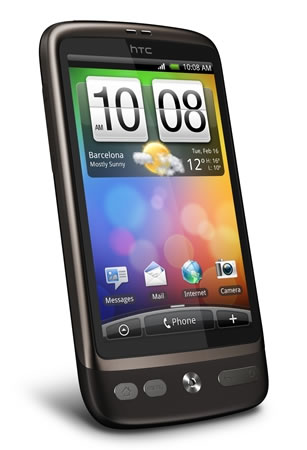Having finally caught up with the modern mobile world on buying the HTC Desire, I have been reluctant to discuss it. The main reason is that nothing but gushing praise would seem rather biased so I wanted to find some faults too. That took time.
As you probably guessed it’s a phenomenal device. I’m not going to repeat others’ “iPhone killer” rhetoric here because it’s irrelevant – with or without Apple’s product, this is a powerhouse of a smartphone and, for me, the best on the market to date. A large capacitive touchscreen with a high-res 800×480 AMOLED display, it looks stunningly crisp with vibrant colours and smooth transitions. Its 1GHz Snapdragon processor makes it fly, coupled with the Android operating system.
Android is a slightly geekier OS than the iPhone’s, but HTC’s Sense user interface sits on top, with attractive widgets that allow for easy customisation and show a lot of info at a glance (e.g. FriendStream which combines friends’ Facebook and Twitter updates). For me it fixes the Nexus One control flaws by inverting them: the touch-sensitive buttons are now physical, while the trackball is replaced with an optical trackpad that is great for fine cursor movement. It’s not secret that I like the tactile feedback of buttons and would still prefer a slide-out physical keyboard, but as soft keyboards go the Desire’s is one of the best I’ve tried.
Now a mature platform, the Android Marketplace has a wealth of apps. Numerically it is still far behind the Apple’s App Store (and isn’t as easy to browse), but most high-quality apps (other than games) are now cross-platform or have equivalents. Android’s open system makes it attractive and easier to develop for, without the need for official approval, so it certainly has the potential to grow rapidly.
The contacts list seamlessly merges my GMail address book with Facebook contacts, including importing profile pics to identify people. Multitasking is a breeze on the Desire, allowing you to stream music with the Spotify app while browsing the web, pausing and resuming everything automatically to receive a call. Other neat tricks include Google’s turn-by-turn SatNav, recently rolled out in the UK, and Flash support, which is welcome but certainly leaves room for improvement.
Video looks gorgeous on the vibrant screen although AMOLED does wash out dramatically in direct sunlight. Codec support is rather limited at present, meaning you’ll need to convert most video files. Previously a nightmare, these days this it is simplified drastically by doubleTwist. Sound quality for voice calls is fine, but I found music playback is rather average: excellent clarity but a lack of depth with virtually non-existent bass. Of a course a phone will never compete with a dedicated PMP and I readily admit I’ve spoiled my ears with Cowon players, but this confirms I will still require a second device.
I’ll discuss specific apps I’m using in a future post.
